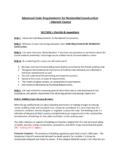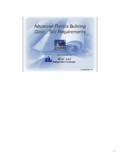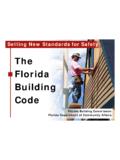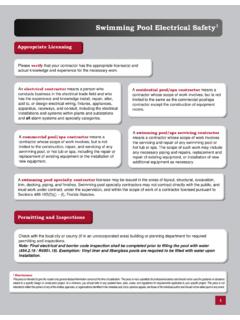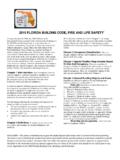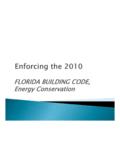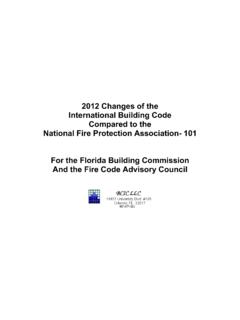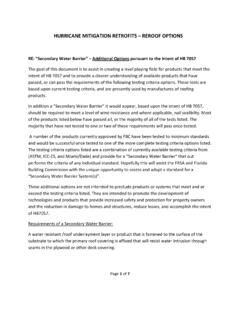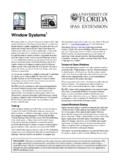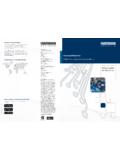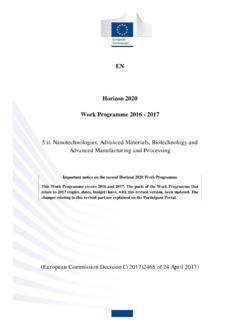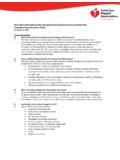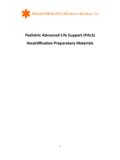Transcription of Florida Building Code Advanced Training: …
1 FBC Advanced training : Residential Roofing Shingles1 Florida Building code Advanced Training: Residential Roofing ShinglesFlorida Building CommissionDepartment of Community Affairs2555 Shumard Oak BoulevardTallahassee, FL 32399-2100(850) 487-1824 presentation reflects roofing provisions of the 2004 Florida Building code , Residential,the 2004 Florida Building code , Building , and the 2004 Florida Existing Building code , as of October, have been several proposed glitch modifications to the Codes; check with the official Florida Building code website, complete up-to date :This module, covering asphalt shingles, is partially adapted from: Florida Building code Advanced training : Roofing, which was developed with primary input from Ms. Lorraine Ross, President, Intech Consulting, Inc., and Residential Roofing and Hurricanes, developed by Building a Safer Florida , Inc. and Kathleen C.
2 Ruppert, University of Florida Energy Extension , note that course content does not emphasize areas regulated by High-Velocity Hurricane Zone (HVHZ) Advanced training : Residential Roofing Shingles2 Course ObjectiveszBecome aware of possible reasons for Roofing Failures in High Wind ConditionszUnderstand FBC Roofing Requirements Permits, plans review, inspections, definitions Wind load requirements Weather protection Structural design requirements Performance requirements Roofing asphalt shingles Florida Existing Building code ReroofingFBC Advanced training : Residential Roofing Shingles3 The 2004 Hurricane season was very active; so was 2005. This slide illustrates several reasons why the roofing professional needs to follow the Florida Building Codes while keeping in mind that the codes set minimumrequirements to safeguard public health, safety, and Advanced training : Residential Roofing Shingles4 The RICOWIWind Investigation ProgramzOak Ridge National Laboratory held two workshops in 1989 devoted to identifying and discussing roof wind uplift issues, alternatives, problems, was to form a committee(The Roofing Industry Committee on Wind Issues RICOWI) Charter approved in 1990 Charter was changed in 1999 to Roofing Industry Committee on Weather Issues, which includes topics such as hail, energy efficiency and durability 1989, Oak Ridge National Laboratory held two workshops devoted to identifying and discussing roof wind uplift issues and alternatives.
3 Discussion of important technical issues included cases of roof wind damage, dynamic testing of roof systems, the importance of sample size for tests, the role of wind tunnels, air retardants and the need for acceptable procedures for ballasted was also concern for the general lack of communication within the roofing industry as to what the problems are, what is being done to alleviate them, and how effectively technology transfer is accomplished within the roofing industry and the Building community. At the conclusion of the workshops a consensus recommendation was to form a committee to address these matters. The Roofing Industry Committee on Wind Issues (RICOWI) was established and the charter approved October Advanced training : Residential Roofing Shingles5 RICOWI / DOE / ORNLzGroups formed to facilitate the Wind Investigation Program (WIP) Includes all of the major roofing trade associations in North America Identifies an event as a windstorm with a minute sustained wind speed of 95 mph or greater when it makes landfall in a populated area of the continental Subsequent to RICOWI's formation, other concerns were raised.
4 For example, the insurance industry conveyed their concern regarding excessive property loss from windstorms. They estimated that from 1984 to 2004 alone, hurricanes and high winds accounted for nearly 64% of catastrophic losses. In August 1992, Hurricane Andrew caused $16 billion in insured losses. A one-month period of hurricanes in 2004 resulted in more than $20 billion in insured and the Department of Energy/Oak Ridge National Laboratory (ORNL) responded to industry involvement by entering into a cooperative Research Development Agreement (CRADA) to facilitate the Wind Investigation Program (WIP). The Program includes all of the major roofing trade associations in North America. The Program identifies an event as a "a windstorm with a 1 minute sustained wind speed of 95 mph or greater when it makes landfall in a populated area of the "FBC Advanced training : Residential Roofing Shingles6 Mission of WIPzInvestigate the field performance of roofing assemblies after major wind storm eventszFactually describe roof assembly performance and modes of damagezFormally report results of investigations and damage modes for substantiated wind speedsThe Wind Investigation Program's (WIP) mission is to investigate the field performance of roofing assemblies after major wind storm events, factually describe roof assembly performance and modes of damage, and formally report results of investigations and damage modes for substantiated wind Advanced training .
5 Residential Roofing Shingles7 Recent RICOWI WIP ActivityzConducted comprehensive roofing investigations of hurricane stricken areas immediately following Hurricane Charley (August 13, 2004) Hurricane Ivan (September 16, 2004) Hurricane Katrina (2005)zThis presentation contains some of the committee s findings for their draft reportzCheck availability of final report, due out in April 2006 ORNL/Department of Energy facilitated and helped fund the training program for wind investigators and has been working with private industry to accelerate the acceptance of more energy-efficient and durable roofing 2004, comprehensive roofing investigations of hurricane-stricken areas were taken following Hurricanes Charley and Ivan. This presentation contains some of the WIP's findings found in a draft of the final report. The method of obtaining a copy of WIP's final report is listed on their web site The results of the Hurricane Katrina data will be covered in a future Advanced training : Residential Roofing Shingles8 WIP Findingsz91 roofs examinedzIssues included: Insufficient attachment Component attachment Blow off of entire roof system Problems with workmanship and improper selection of materialsThe WIP investigation team reported that wind-related damage conditions on steep slope roofs observed on the 91 roofs ranged from minor to extensive.
6 Damage conditions included insufficient attachment; component detachment; complete displacement (blow-off) of the roof system. Workmanship and improper material selection issues were major factors in observed damages. The data and the subsequent assessments will hopefully be used by product manufacturers, roofing system designers, roofing contractors and Building officials to improve the performance of roofing systems in high winds. The efforts expended by the team members, the financial support from all the contributors and the help of the sponsoring organizations will no doubt be of great benefit to the roofing industry in the Advanced training : Residential Roofing Shingles9 Events believed associated with initiation of wind damagezInsufficient attachmentzFastener placementzBuilding code changeszWorkmanshipzImproper material selectionzStructural failurezAge and maintenancezWinds in excess of code designEvents believed associated with initiation of wind damage included the following: Insufficient attachment: Insufficient fastener attachment was commonly observed in both the types and the number of fasteners used.
7 Cases were observed where the fastener was not sufficient, in conjunction with the frequency of placement, to resist the wind forces. Fastener placement: Examples of roof failure occurred where fasteners and placement patterns were used that would not normally have been specified or prescribed for a particular application. Building code changes: It was found that the fastening requirements specified in a later version of the Building code were an improvement over those of the earlier code . Insufficient attachment was also prevalent in the securing of substrates and framing members. Workmanship: The teams observed instances where the construction of the roof covering compromised its performance against the hurricane-force winds. Cases were found of missing or improperly placed fasteners. Other cases were found where the construction of the Building s roof covering was not according to the governing code or standard practice at the time of construction.
8 Improper material selection: Examples were found of roofs where either one component or a combination of components failed to withstand the force of winds. The failure of one component on the roof or used as part of the roof structure was found to influence the performance of other materials. Roofs that were exposed to and survived the hurricane winds were supported by an entire system having the required materials installed according to specification. Structural failure: Cases were observed in which the structural integrity of the Building was breached and the roof failed. Age and maintenance: In some cases in which similar material types were used, newer roofs performed better in the hurricanes than did older materials. Some of the performance differences between older and newer materials can be attributed to better specified application methods, but in similar roofs with equivalent application methods, it was observed that newer roofs fared better than older ones.
9 Examples were found in which the performance of the roof was weakened by corrosion or deterioration of components. Winds in excess of code design: In some instances, the roof system failed even though it was constructed according to an appropriate updated specification. These examples were found for both the roof covering and the Building s Advanced training : Residential Roofing Shingles10 Lack of proper fastenersImages courtesy of: RICOWI Jerry VandewaterThe next several slides depict examples of roof covering Advanced training : Residential Roofing Shingles11 Notice shingle fasteningImages courtesy of: RICOWI Jerry Vandewater Rusty nails A lot of nails still in place Shingles pulled offFBC Advanced training : Residential Roofing Shingles12 Shingles tore loose from 6 nails placed in seal courtesy of: RICOWI Joe WilsonPlacing the nails in the seal strip is a less-than-optimal location.
10 All dimensional shingles have nail the WIP investigators did see shingles that worked especially newer shingles and architectural Advanced training : Residential Roofing Shingles13 Composite shingle roof some hip/ridge loss. Nailed with 6 nails per courtesy of: RICOWI Joe WilsonIn higher wind areas, newer shingles with six nails had less damage on hips or Advanced training : Residential Roofing Shingles14 Neighbors: separated by age1 month old10 years oldImages courtesy of: RICOWI Joe WilsonFBC Advanced training : Residential Roofing Shingles15 Neighbors: design differenceHip versusgable applicationImages courtesy of: RICOWI Joe WilsonThe hip roof only had minor damage on the Advanced training : Residential Roofing Shingles16 Image courtesy of: Bill ZoellerLet's look at roof hip roofs have been reported to have fewer problems, roof damage still roofs are believed to be less prone to damage than gable roofs because.
